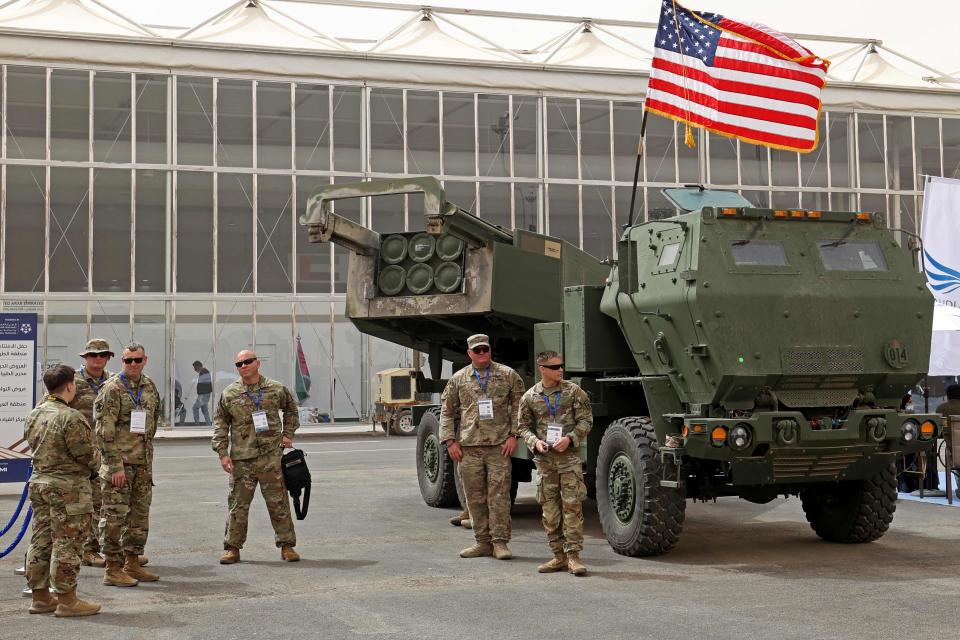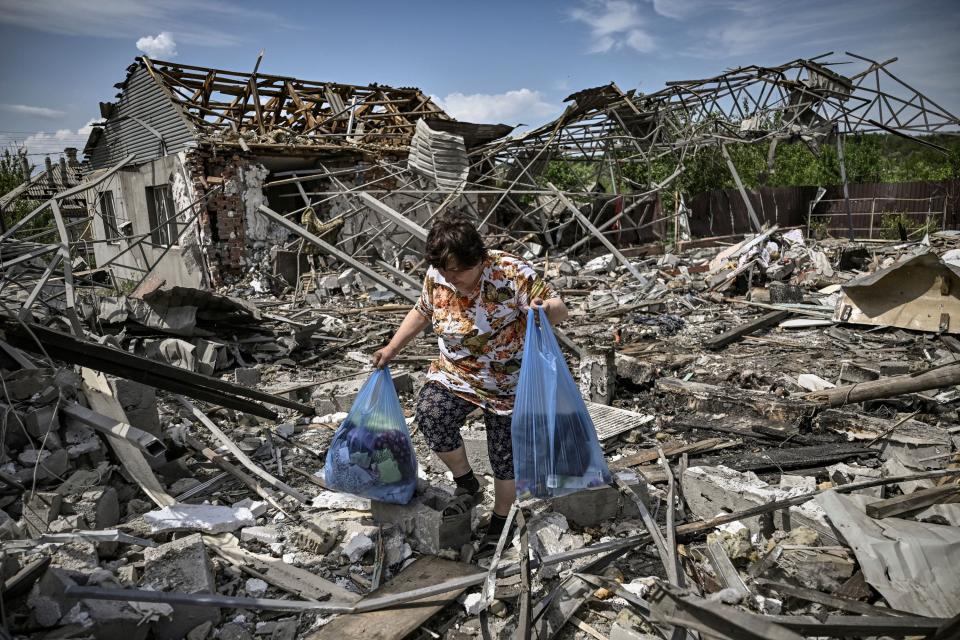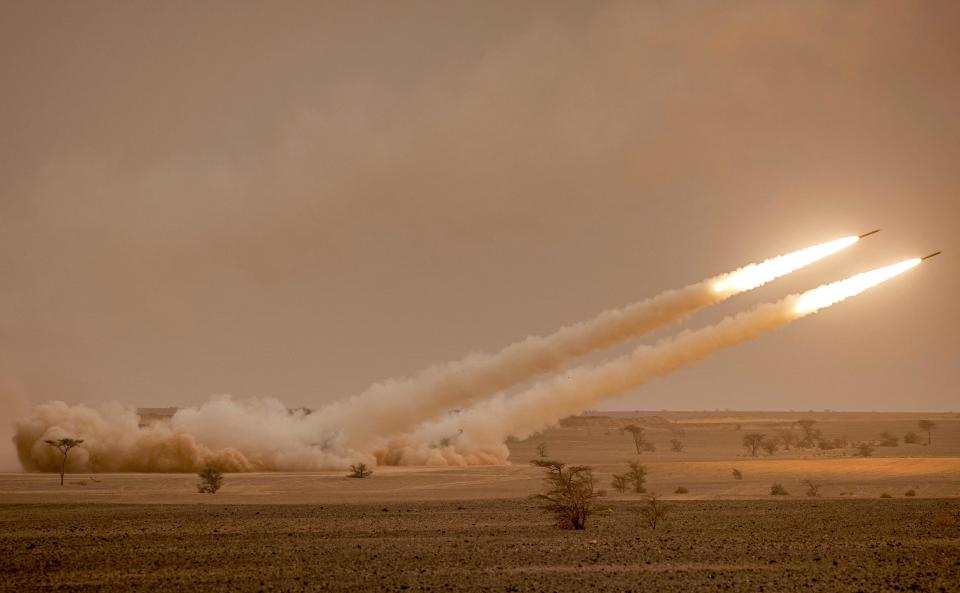Biden is giving Ukraine the deadliest weapons yet. Will it make a difference?
- Oops!Something went wrong.Please try again later.
- Oops!Something went wrong.Please try again later.
- Oops!Something went wrong.Please try again later.
WASHINGTON – President Joe Biden's decision to provide Ukraine with longer-range precision rockets unleashed angst in Moscow and applause in Kyiv.
But it's not clear yet how much of a difference the advanced weapons will make in what has become a stalemated, grinding conflict with no clear endgame. It also remains to be seen how Russia will respond to the U.S. move, which will once again shift the playing field in the 3-month-old war.
As the U.S. has ramped up the flow of American-made weapons to Ukraine, the Kremlin has increasingly tried to frame its invasion of Ukraine as a proxy war between Washington and Moscow, even though Biden has repeatedly said he would not send American troops to fight in the conflict.
Text with the USA TODAY newsroom about the day’s biggest stories. Sign up for our subscriber-only texting experience.
"The Biden administration argues this most recent military aid package will help Kyiv target Russian artillery behind the front and give the Ukrainians more leverage when or if negotiations resume," said Daniel DePetris, a fellow at Defense Priorities, a Washington-based think tank that advocates for military restraint.
"Unfortunately, no negotiations are on the horizon," he said. "Neither side is ready to concede anything.”
Here's a look at four key questions about Biden's latest decision and its potential impact:
'Shoot-and-scoot': What's the advantage of the new missiles?
The mobile rocket artillery launcher the Pentagon is providing to Ukraine can strike targets from about 40 miles away. Right now, Ukrainian troops are using U.S.-provided M777 howitzers, which have a range of under 20 miles.
Other Western allies have provided similar howitzers in what has become an artillery duel on the largely open terrain of Ukraine's eastern Donbas region.
Known as High Mobility Rocket Systems, the new missiles will allow Ukrainian forces to attack deep beyond the front line of the war in eastern Ukraine and compel Russian commanders to move their forces back to avoid attacks.
Mounted on a truck with an armored cab for the crew, the system has a pod of six rockets. Once fired, the crew can move the truck quickly to avoid counterattack, a maneuver known as shoot-and-scoot.
The HIMARS launchers can be used to target Russian forces that have massed in relatively confined areas on the Donbas, said Sen. Richard Blumenthal, D-Conn., a member of the Armed Services Committee who has advocated arming the Ukrainians with increasingly lethal weapons.
"They widen the zone of threat to Russian forces," Blumenthal said. "So they can compel the Russians to withhold their forces, force them back and to reorient whatever their plans they have to avoid vulnerability."
Visual guide: What weapons are being used in Russia's invasion of Ukraine?
US aid to Ukraine could hit $53B: Here's what it covers, how it compares and who pays for it

Why is Biden's decision seen as a significant escalation of the U.S. role in the war?
Russian Foreign Minister Sergey Lavrov warned last week that giving Ukraine weapons capable of striking inside Russia’s borders would be a serious escalation.
On Wednesday, Putin’s press secretary accused the United States of “deliberately and diligently pouring fuel on the fire." He said the Kremlin doesn’t trust Kyiv’s assurances that the U.S. rocket launch systems will not be used to attack Russia.
The Pentagon and White House have asserted the rockets do not have a range beyond 40 miles. And in announcing the transfer of the advanced rocket system, Biden made sure to say the U.S. is not trying to topple Putin.
“As much as I disagree with Mr. Putin, and find his actions an outrage, the United States will not try to bring about his ouster in Moscow,” Biden wrote in an opinion piece published Tuesday evening in The New York Times.
On Wednesday, Secretary of State Antony Blinken dismissed questions about how Washington could ensure Moscow would not take the move as a provocation.
“Simply put, the best way to avoid escalation is for Russia to stop the aggression and the war that it started,” Blinken said at a news conference Wednesday with NATO Secretary-General Jens Stoltenberg. “They started the conflict. They can end it at any time and avoid any concerns about miscalculations or escalation.”
Blinken also noted the Ukrainians have given assurances they will not use the systems against targets inside Russia and said “there’s a strong trust bond between Ukraine and the United States.”

EU ban on Russian oil: Expect a 'cruel summer' ahead
Watch: Lviv artists turn Russian missiles into patriotic art to raise funds for Ukrainian army
Will this change the course of the war in Ukraine?
Right now, the war is one of attrition, and “neither side is winning or losing,” said Evelyn Farkas, a former deputy assistance secretary of defense for Russia and Ukraine.
But because the U.S. is sending Ukraine attack helicopters, tanks, howitzers and other weapons, “the Ukrainians should have the opportunity to seize the offensive,” said Farkas, who is now executive director of the McCain Institute, which focuses on promoting democracy, human rights and other global issues.
Sergiy Kyslytsya, Ukraine’s ambassador to the United Nations, said the more advanced rocket systems will have a “very fundamental impact and importance.”
“Both sides are stalled,” Kyslytsya said Wednesday in a broadcast interview with The Washington Post. Russians are killing 60 to 100 Ukrainian soldiers a day, he said, but have made very limited advances.
Without additional weaponry and munitions, the stalemate “may last for quite a long time and wouldn't really be helpful to any of us,” including the U.S. and European allies, he said.
But others aren't convinced it will be a game-changer.
"It's not a magic bullet," Blumenthal said. "It's significant but not necessarily decisive."
Four of these systems were pre-positioned in Europe so that they can be fielded quickly, said Colin Kahl, the Pentagon's undersecretary for policy.
But Kahl noted that it will take three weeks to train Ukrainian troops to operate and maintain the HIMARS systems. "These are not turnkey," he said.
Russia has made incremental gains in eastern Ukraine, a senior defense official said last week, concentrating its efforts on smaller objectives. Despite its loss of more than 1,000 tanks and thousands of troops, Russia retains significant advantages in soldiers, artillery and armor. Ukrainian leaders have been pleading for the HIMARS rocket launchers for weeks to better their chances.
HIMARS will give Ukrainian forces advantages over the Russians in precision attacks, Blumenthal said. That could allow them to claw back some of the Russian gains, but the war is still likely to be a "grinding slog" for some time, he said.
Though very precise, the HIMARS rocket system will not tip the balance in the war in Ukraine's favor, Kahl said.
"No system is going to win the war," Kahl said.
'A charged moment for the world':Blinken says war in Ukraine will not distract US from China threat
In Sports: Ukraine takes political path to qualifying for World Cup
What's next from Washington?
In announcing the decision, Biden seemed to be walking a tightrope – answering Ukraine’s pleas for more sophisticated weaponry in the face of Russia's latest assault without provoking the Kremlin to escalate a war that many fear could spill over into other parts of Europe.
"We do not seek a war between NATO and Russia," the president wrote in his op-ed.
Colin Smith, a defense researcher and expert on the Russian military at the Rand Corp. think tank, noted the most advanced U.S. HIMARS rockets have a range of 100 miles, which would put several Russian cities under potential threat.
The U.S. has not opted the send those rockets.
Asked how far the U.S. would go in assisting Ukraine's military, Blinken declined to give a specific answer Wednesday.
“At every step along the way, we have evaluated what we believe Ukraine needs … to defend itself effectively,” he said. “And of course, that's changed through the course of this aggression. What they needed to deal with threats to Kyiv are very different from what they need to deal with what's now happening in southern and eastern Ukraine.”
Live Ukraine updates: Oligarch's $300M yacht untouchable in UAE port; US, Germany to provide missile systems:

This article originally appeared on USA TODAY: Biden's decision to send longer-range rockets to Ukraine: What to know

